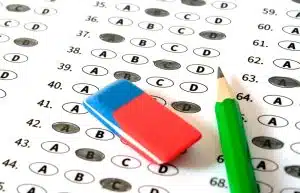The Massachusetts Institute of Technology (MIT) consistently ranks as one of the top universities in the world. MIT even snagged the #1 spot in the latest QS World University Rankings. But with an acceptance rate of just 4.5% for the Class of 2028, the competition is seriously tough. Only the most qualified students get into MIT.
So, how do you make it? Sure, strong academics are a huge part of it, but it’s not everything. MIT wants character. They want curious, creative problem-solvers, people who geek out over challenges. Knowing what MIT looks for and focusing on those areas will definitely help boost your chances of standing out in such a competitive crowd.
In this guide, we’ll break down everything you need to know about how to get into MIT. From GPA expectations to writing those all-important essays, you’ll get the insights you need to tackle your application with confidence.
- How Hard Is It to Get into MIT?
- MIT Admission Requirements
- MIT GPA Requirements
- MIT SAT Scores
- MIT ACT Scores
- How to Increase Your Chances of Getting into MIT
- MIT Application Deadline
- Frequently Asked Questions
- Takeaways
How Hard Is It to Get into MIT?
Let’s cut to the chase: getting into MIT is tough. Like, really tough. For the Class of 2028, MIT received 28,232 applications, but only 1,284 lucky students got in. That’s an acceptance rate of just 4.5%. So, for every 100 students who applied, fewer than five made the cut.
MIT’s acceptance rate is right up there with the most competitive schools in the world. Ivy League universities, for example, admit between 4% to 8% of applicants. Harvard, the most selective of them, admitted only 3.6% of applicants for the Class of 2028, followed by Yale at 3.7% and Columbia at 3.85%.
MIT’s 4.5% acceptance rate is on par with Princeton, which also admitted 4.5% of its Class of 2027. So, even though MIT isn’t technically Ivy League, it’s just as elite. It’s even more selective than Brown (5.2%), UPenn (5.4%), Dartmouth (5.3%), and Cornell (7.9%).
Looking at MIT’s recent acceptance trends, things have stayed pretty steady over the last few years:
| MIT Class | Acceptance Rate |
| Class of 2024 | 3.9% |
| Class of 2025 | 4.1% |
| Class of 2026 | 4.7% |
| Class of 2027 | 4.8% |
| Class of 2028 | 4.5% |
As you can see, MIT’s acceptance rates have recently hovered between 3.9% and 4.8%. While these tiny shifts don’t seem like much, they’re a reminder that getting in is seriously competitive year after year.
The bottom line? If you’re wondering how to get into MIT, the numbers tell you this: the competition is fierce, and every piece of your application matters.
MIT Admission Requirements
If you’re aiming to get into MIT, you need to understand their admissions process inside and out. MIT takes a holistic approach, meaning they’re looking at your entire application: your academics, test scores, extracurriculars, essays, and recommendation letters. You need to show you’re well-rounded. Knowing how to get into MIT is about grasping how all these pieces fit together.
First off, MIT has its own application portal. No Common App or Coalition App here. Once you create an account, you’ll be able to submit your application, track progress, and even make updates.
Here’s a breakdown of what you need to submit:
- Transcript of records. This is your high school transcript, which shows your GPA and the level of rigor in your courses.
- Letters of recommendation. MIT asks for two teacher recommendations (one from math/science, one from humanities/social sciences) and one from your counselor.
- Application essays. You’ll need to write five short-answer essays (100-200 words each).
- Extracurricular activities. MIT cares about quality over quantity. You can only list four activities, so make sure they highlight your leadership, passion, or unique talents.
- Standardized test scores. You’ll need to submit either SAT or ACT scores. These scores help MIT gauge your readiness for their challenging courses.
- Interview (optional). MIT tries to offer interviews to as many applicants as possible, but if it’s waived, don’t stress—it won’t hurt your chances.
- Creative portfolios (optional). If you’re into research, arts, or hands-on projects, you can submit a portfolio through SlideRoom. This is optional, but it can be a way to show off what makes you stand out.
While all of these pieces matter, MIT places the most emphasis on your personal character. According to their Common Data Set for 2022-2023, the only thing marked as “very important” is “character/personal qualities.” They want students who are not only smart but also curious, driven, and thoughtful. Integrity, resilience, and empathy matter just as much as your test scores and GPA.
Other key factors include the difficulty of your coursework and any particular talents or abilities you have. MIT wants to see that you’ve taken tough classes, especially in math and science, and that you’ve done well in them. Special talents, whether academic or otherwise, can also make a difference.
MIT also considers other factors, but they don’t carry as much weight. Things like class rank, first-generation status, geographic location, and volunteer work can help, but factors like alumni connections, state residency, and demonstrated interest in MIT aren’t considered at all.
While these aren’t strict requirements, MIT suggests taking the following subjects in high school:
- 4 years of English
- 4 years of Math
- 4 years of Science
- 2 years of Foreign Language
- 2 years of Social Studies
To improve your chances further, it’s recommended to take advanced high school courses as they’ll help you prepare for the rigors of college.
In short, understanding these requirements is key to knowing how to get into MIT. Each part of the application is meant to give the admissions committee a full picture of who you are and how you’ll contribute to their community. Focus on excelling in each area, and you’ll put yourself in the best possible position for admission.
MIT GPA Requirements
MIT doesn’t have a set minimum GPA, but let’s be real—you’re going to want to aim high. If you’re planning to apply, just know that most admitted students have stellar GPAs, and taking advanced courses is a great way to stand out.
MIT average GPA
MIT doesn’t officially share the average GPA of its admits, but historically, it’s around 4.2 on a weighted scale. Moreover, 97% of MIT students are in the top 10% of their graduating class, and 100% are in the top 25%.
But it’s not just about the GPA. MIT wants to see that you’ve challenged yourself with the hardest courses your school offers. Most students accepted have taken rigorous courses like AP, IB, or honors classes, which bump their GPA above a standard 4.0. That means aiming for advanced math, science, and other demanding classes that prove you’re ready for MIT-level work.
In short, ideally, you want a GPA around 4.2 or higher to be competitive. If you’re below that, don’t panic—MIT looks at more than just your grades.
What to do if your GPA is below average
If your GPA isn’t quite up to par with typical admits, there are still ways to strengthen your application. MIT looks at everything: your essays, extracurriculars, letters of recommendation, and personal qualities. If your GPA is a bit lower, focus on showing leadership in your extracurriculars, a deep passion for research, or any unique skills that set you apart.
Also, course difficulty matters. If your GPA is on the lower side but you’ve taken the most challenging courses your school offers, MIT will factor that in. Showing growth, like improving grades in tougher classes, can also work to your advantage.
MIT SAT Scores
Unlike some schools that have gone test-optional, MIT still requires SAT or ACT scores. They see these scores as an important measure of how ready you are for their intense curriculum. There’s no minimum score, but knowing what the average admitted student scores will give you a sense of what you’re up against.
MIT average SAT
MIT admits students with really high SAT scores. Here’s how the composite numbers break down:
| 25th Percentile SAT Composite Score | 50th Percentile SAT Composite Score | 75th Percentile SAT Composite Score |
| 1520 | 1550 | 1570 |
Here’s a deeper look at the section scores:
| Section | 25th Percentile Score | 50th Percentile Score | 75th Percentile Score |
| SAT Evidence-Based Reading and Writing (EBRW) | 730 | 760 | 780 |
| SAT Math | 790 | 800 | 800 |
Almost all admitted MIT students (99.2%) score between 1400 and 1600 on the SAT composite, with 92% hitting between 700 and 800 on the Evidence-Based Reading and Writing section. For math, it’s even more intense—100% of admitted students score between 700 and 800, and many of them actually hit the perfect 800.
What does this mean for you? To be truly competitive, especially in math, you should aim for a score that’s at or above the 75th percentile. So, if you can get close to 1570 overall, you’ll be in a much stronger position in MIT’s admissions process.
But don’t panic if you’re a little below these numbers. MIT looks at more than just scores. Their holistic review process means they’ll consider your extracurriculars, essays, and especially your personal qualities. MIT loves students who are curious and driven.
Does MIT Require SAT?
Yes, MIT requires either SAT or ACT scores. While lots of schools have moved to test-optional policies, MIT believes these scores are still helpful in seeing how academically prepared you are—especially in math and science. They don’t require the SAT optional essay or ACT writing section, though.
MIT accepts both paper and digital SAT versions, and while they don’t require the writing portion, strong communication skills are important to them. You’ll have writing requirements built into your entire time at MIT, no matter what you study, so having a handle on your writing skills matters.
MIT ACT Scores
When it comes to ACT scores, MIT doesn’t set a strict minimum, but you’ll want to aim high if you’re serious about getting in. Like the SAT, the ACT helps MIT gauge if you’re ready for its tough curriculum, especially in math and science.
MIT average ACT
Most admitted students are scoring at the top of the ACT scale. Almost all of them (99.7%) have a composite ACT score somewhere between 30 and 36. To break it down, here’s what the ACT scores typically look like for MIT applicants:
| 25th Percentile ACT Composite Score | 50th Percentile ACT Composite Score | 75th Percentile ACT Composite Score |
| 35 | 35 | 36 |
As for the subject breakdown:
| Subject | 25th Percentile Score | 50th Percentile Score | 75th Percentile Score |
| ACT Math | 35 | 35 | 36 |
| ACT English | 35 | 35 | 36 |
MIT hasn’t shared specific data for ACT Reading and Science, but they did reveal that 97.5% of admitted students scored between 30 and 36 on ACT Reading, and 99.2% hit that range on ACT Science.
So, aiming for a perfect 36, especially in math and science, will put you in a strong position. If you don’t quite hit those marks, it’s not the end of the road—you’ll just need to really shine in other parts of your application to balance it out.
Does MIT prefer the ACT or SAT?
MIT doesn’t lean toward the SAT or ACT. Either is fine. Historically, more students have submitted SAT scores—78% for the Class of 2026—while 32% submitted the ACT. But really, MIT doesn’t care which one you choose. The key is to perform well because standardized test scores still play a big role in figuring out how to get into MIT.
How to Increase Your Chances of Getting into MIT
Getting into MIT is about standing out in a pool of already exceptional students. To really shine, you’ll need to:
1. Keep your GPA high.
A strong GPA is one of the first things MIT looks at. On average, admitted students have a GPA of 4.2, which is above the standard 4.0. Why? Because these students are taking advanced courses—AP, IB, or honors classes—that boost their GPA and show they’re up for a challenge. If you’re aiming for MIT, you need to take the toughest classes available and excel in them.
How do you keep that GPA high? Start with solid study habits. Stay organized—keep track of deadlines, exams, and assignments so nothing slips through the cracks. If you’re struggling in a class, don’t wait—ask for help, whether it’s from a teacher, a tutor, or a friend who’s acing the subject.
Also, engage in class. Asking questions and actively participating can help you understand the material better. And, of course, manage your time wisely. Spread out studying over days instead of cramming the night before. Advanced classes aren’t easy, but with effort and strategy, you can keep your GPA competitive.
2. Crush the SAT/ACT.
Unlike some schools that have gone test-optional, MIT still requires SAT or ACT scores, and they matter. To stay competitive, aim for the top 25% of MIT admits: around a 1570 on the SAT or a 36 on the ACT. A perfect score in math can give you an extra edge since MIT is, well, MIT.
To prepare for these tests, start with practice exams to figure out where you need the most work. If the SAT’s math section trips you up, focus there. If the ACT’s science section gives you a headache, spend more time on that. Whatever you do, practice under timed conditions so you get used to the pace of the real exam.
And if you’re struggling to hit your target score, don’t hesitate to sign up for a prep course or get a tutor. Consistent, focused study over a few months will give you the best shot at improving your score without burning out.
These strategies will help, but remember, MIT looks at more than just grades and scores. It’s all about who you are as a person, too.
3. Write exceptional essays.
Speaking of who you are as a person, let’s talk about essays. MIT asks for five short essays, each digging into different aspects of your personality, interests, and experiences.
And here’s the thing: MIT values character the most in its holistic review process, so these essays are your chance to showcase what makes you you. Sure, they’ll see your grades and scores, but through your essays, they want to get a sense of your curiosity, resilience, leadership, and passion for learning.
To nail your essays, focus on being real and reflective. Instead of just listing out your accomplishments, go deeper—talk about how your experiences have shaped you. For example, if you’re writing about collaboration, don’t just say, “I worked on a group project.” Instead, explain how you handled different opinions, resolved conflicts, or brought a unique idea to the table. MIT wants to see how you think and act, not just what you’ve done.
Take note of MIT’s own solid advice on writing your essays: “You should certainly be thoughtful about your essays, but if you’re thinking too much—spending a lot of time stressing or strategizing about what makes you ‘look best,’ as opposed to the answers that are honest and easy—you’re doing it wrong.” Authenticity is key. Write what’s true to you, not what you think they want to hear.
One way to approach your essays is by picking specific moments that highlight your personal traits. Let’s say you’re responding to a prompt about overcoming challenges. Tell a story about a time you took on a leadership role during a tough situation. Walk through how you stayed calm under pressure, coordinated with others, and what you learned from it. Real-life examples make your essays stand out and help MIT get a feel for how you tackle challenges.
MIT essay prompts
For the 2024-2025 admissions cycle, here are the essay prompts you’ll need to respond to:
- What field of study appeals to you the most right now? (Note: Applicants select from a drop-down list.) Tell us more about why this field of study at MIT appeals to you. (100 words)
- We know you lead a busy life, full of activities, many of which are required of you. Tell us about something you do simply for the pleasure of it. (150 words)
- While some reach their goals following well-trodden paths, others blaze their own trails achieving the unexpected. In what ways have you done something different than what was expected in your educational journey? (225 words)
- MIT brings people with diverse backgrounds together to collaborate, from tackling the world’s biggest challenges to lending a helping hand. Describe one way you have collaborated with others to learn from them, with them, or contribute to your community together. (200 words)
- How did you manage a situation or challenge that you didn’t expect? What did you learn from it? (225 words)
Remember: be yourself and show MIT how you think, lead, and grow. That’s how to get into MIT—not by ticking boxes, but by telling your story in a way that only you can.
4. Excel in extracurricular activities.
MIT wants students who shine outside the classroom too. If you’re aiming to figure out how to get into MIT, you’ve got to show that you’re not just good with textbooks but also have passions that drive you, especially in areas like science, technology, and innovation.
For example, if you’re into engineering, joining a robotics club or competing in something like the FIRST Robotics Competition can be a great fit. If computer science is your thing, coding competitions or personal software projects are ways to stand out. MIT appreciates students who are not just well-rounded, but also have a deep passion for their chosen field.
MIT admissions officers can easily tell the difference between students who are genuinely passionate and those who are just trying to build a resume. If you’re applying to MIT because you’re excited about tech and innovation, your extracurriculars should reflect that.
Getting involved in research projects, internships, or summer programs that show your commitment to STEM fields can be a game-changer. Prestigious programs like the MIT Research Science Institute (RSI) are great examples of opportunities that align with what MIT values—pushing the boundaries of knowledge.
That said, don’t limit yourself to only STEM activities. Leadership in any field, from clubs to community service, is also important. MIT values students who make an impact, so whether you’ve founded a non-profit, led a student group, or launched a meaningful project, these experiences show your initiative and leadership. It’s all about pursuing what you love—and making a difference.
5. Get strong letters of recommendation.
MIT asks for two teacher recommendation letters and one from your counselor. They suggest one of the teacher letters come from a math or science teacher and the other from a humanities or social science teacher. Strong recommendation letters can take your application from good to great. MIT values character, and your teachers and counselor are in a prime position to speak to your personal qualities.
To get strong recommendation letters, start early. Build solid relationships with your teachers and counselor by participating in class, asking thoughtful questions, and showing your interest in the subject. When it’s time to ask for letters, pick teachers who know you well and can speak to not just your academic skills but also your character—qualities like curiosity, resilience, and work ethic.
Be sure to ask for the recommendations well in advance, ideally a month before the deadline, and provide them with a list of your achievements and activities to help them write a more tailored letter. After they’ve submitted your letters, don’t forget to thank them with a follow-up note—it goes a long way in showing your appreciation.
6. Apply through Early Action.
MIT gives you two options for applying: Early Action (EA) or Regular Action (RA). The big difference? Deadlines. EA apps are due in November, while RA apps can be submitted by January. EA might be the way to go if you’re feeling confident about your application.
For the Class of 2028, MIT’s EA acceptance rate was 5.3%. Compare that to the RA round, which had a much larger pool and only a 2.6% acceptance rate. Sure, the difference may not seem huge, but when you’re up against MIT’s competition, even the smallest advantage can make a big impact. Every little edge counts.
EA at MIT is non-binding, which means if you get in, you’re not locked into attending. You can still apply to other schools as long as their EA policies aren’t restrictive. This gives you more freedom compared to some other schools with binding early decision policies. But heads up: if you’re rejected in EA, you can’t try again during RA.
Another perk of EA? You find out your decision by mid-December, giving you time to enjoy your senior year stress-free if you get in. If you’re deferred or denied, you’ll still have time to shift your focus to other schools. Understanding how these cycles work can help you figure out when it’s best for you to apply, giving you more control over how to get into MIT.
MIT Application Deadline
When you’re applying to MIT, keeping track of deadlines is key to staying on top of things. Here’s the breakdown for both Early Action and Regular Action timelines:
| Date | Event |
| Mid-August | Application Start |
| November 1 | Early Action Deadline |
| Mid-December | Early Action Notification |
| January 6 | Regular Action Application Deadline |
| Mid-March | Regular Decision Notification |
| May 1 | Reply Date |
Make sure you submit everything before the deadlines to avoid last-minute panic. EA decisions are typically out by mid-December, while RA applicants hear back by mid-March (typically on Pi Day, March 14). If you get an offer, you’ll need to let them know by May 1 (National College Decision Day) whether you’re accepting or not.
Frequently Asked Questions
1. What is the acceptance rate of MIT?
MIT’s acceptance rate for the Class of 2028 sits at a low 4.5%, making it one of the toughest schools to get into. The competition is fierce, with tons of highly qualified applicants aiming for a spot.
2. Is MIT test-optional?
No, MIT still requires you to submit SAT or ACT scores. Unlike many schools that have gone test-optional, MIT believes these scores are key in evaluating how prepared you are for its academic demands.
3. What GPA do you need to get into MIT?
While MIT doesn’t set a minimum GPA, most students getting in have an average GPA around 4.2. That’s above the standard 4.0, thanks to AP, IB, or honors classes. Taking challenging courses can definitely boost your chances.
4. What is MIT known for?
MIT is world-famous for its dominance in STEM, particularly engineering and computer science. It’s also a hub for innovation and entrepreneurship, with groundbreaking discoveries regularly coming from both students and faculty.
5. How much is MIT tuition?
For the 2024-2025 academic year, tuition is $61,990. Add in housing and fees, and you’re looking at around $85,960 in total. But MIT offers strong financial aid packages, with many students receiving grants that make it way more affordable.
Takeaways
If you’re figuring out how to get into MIT, here are five key things you need to know:
- MIT’s acceptance rate is a tiny 4.5%, so you’ll need to really stand out to make the cut.
- Shoot for a GPA around 4.2 or higher, with a focus on challenging classes like AP, IB, or honors. MIT loves to see that you can handle tough coursework.
- To stay competitive, aim for an SAT score of 1570+ or an ACT score in the 35-36 range.
- MIT cares a lot about what you do outside of class. Strong extracurriculars, killer essays, and glowing recommendation letters can give you an edge.
- Consider talking to a college admissions consultant who can help you polish your application and give you an extra boost toward getting into MIT.

















































